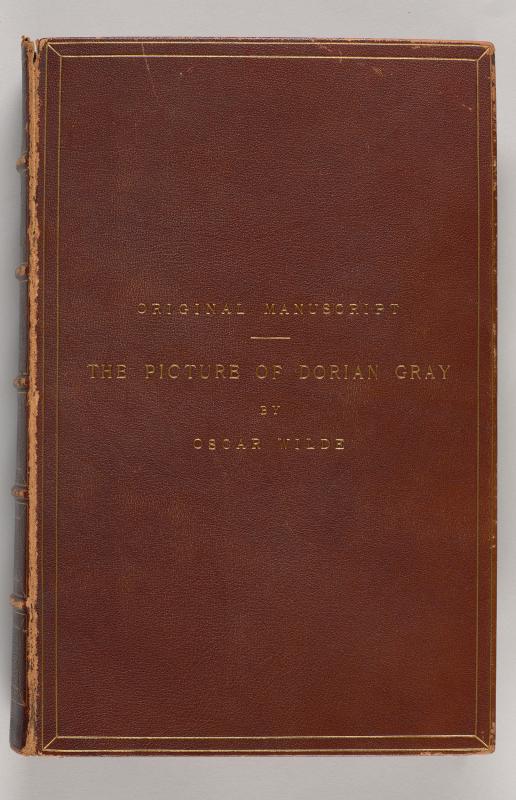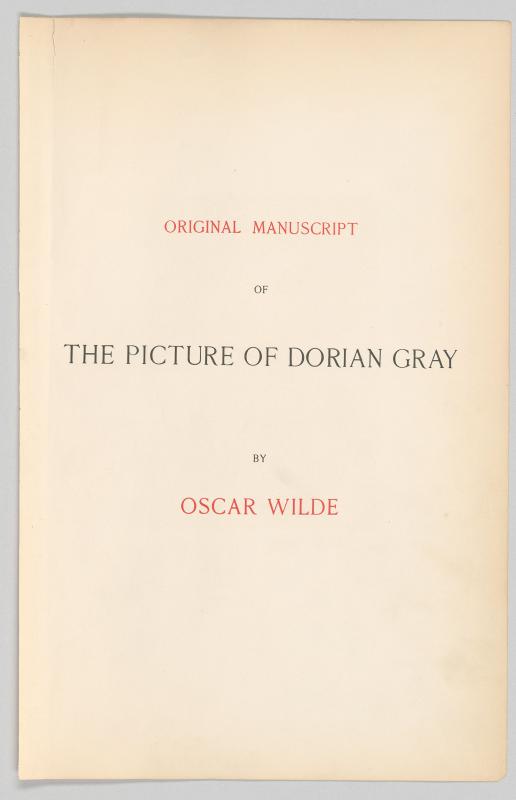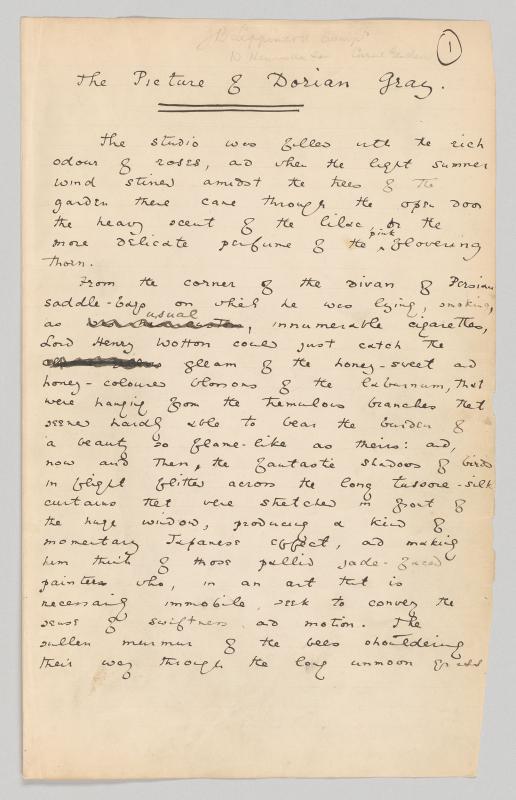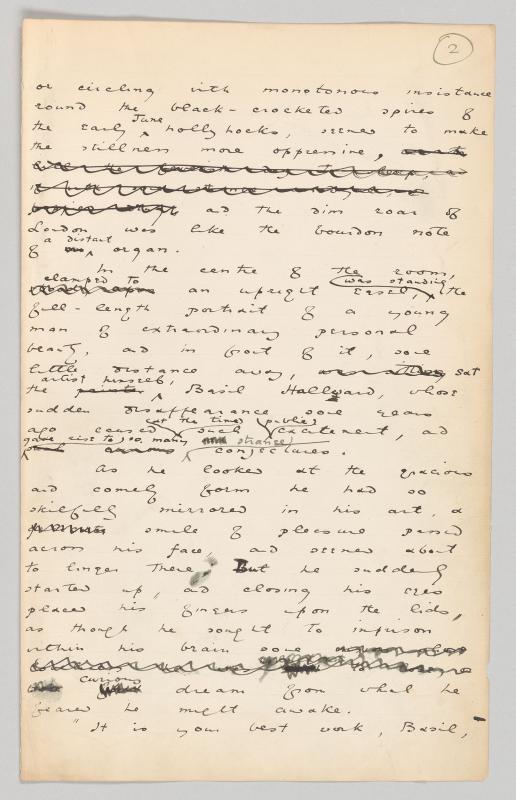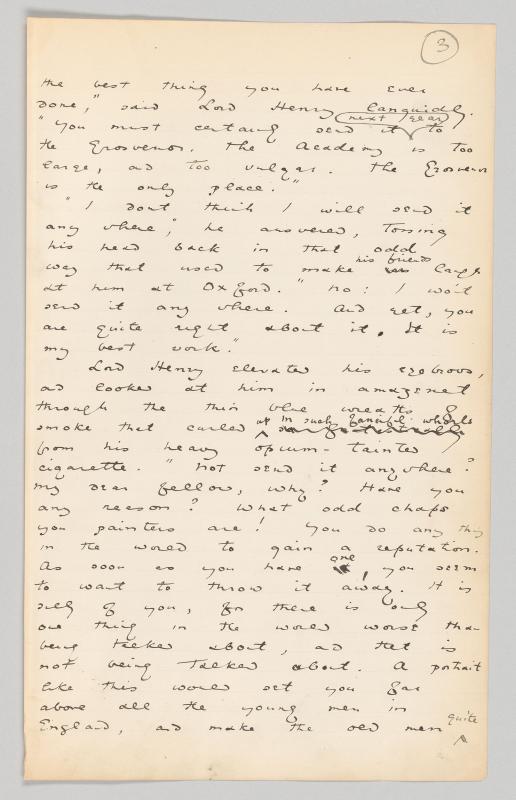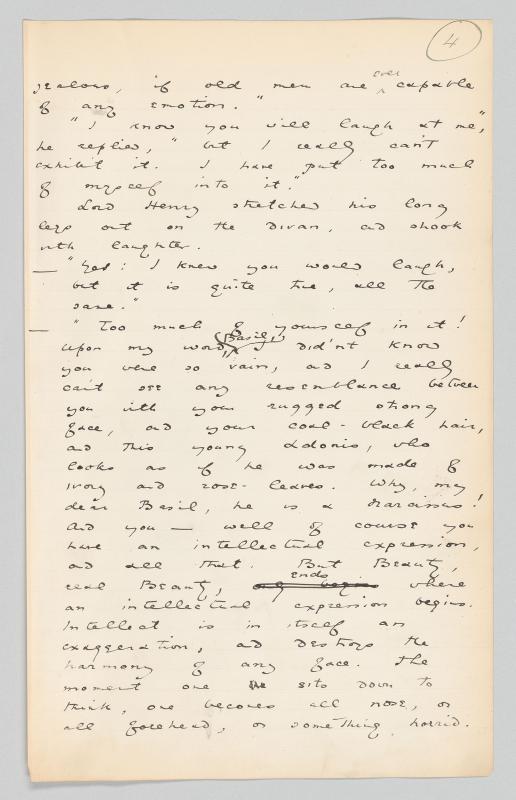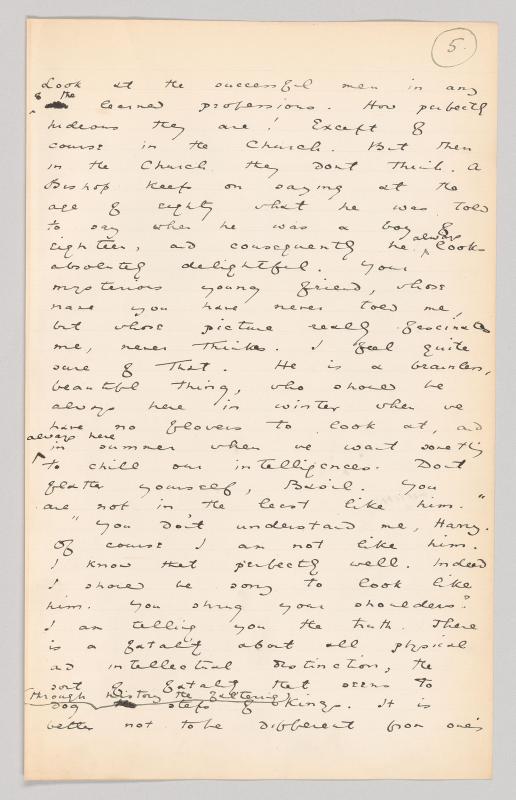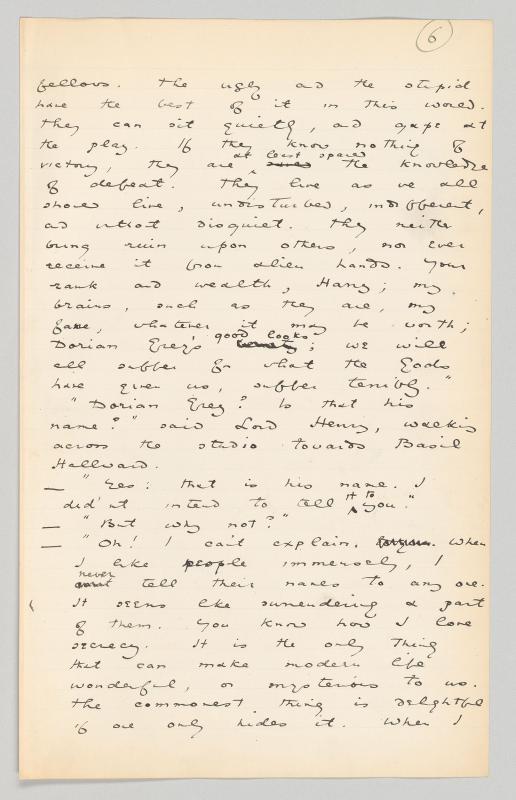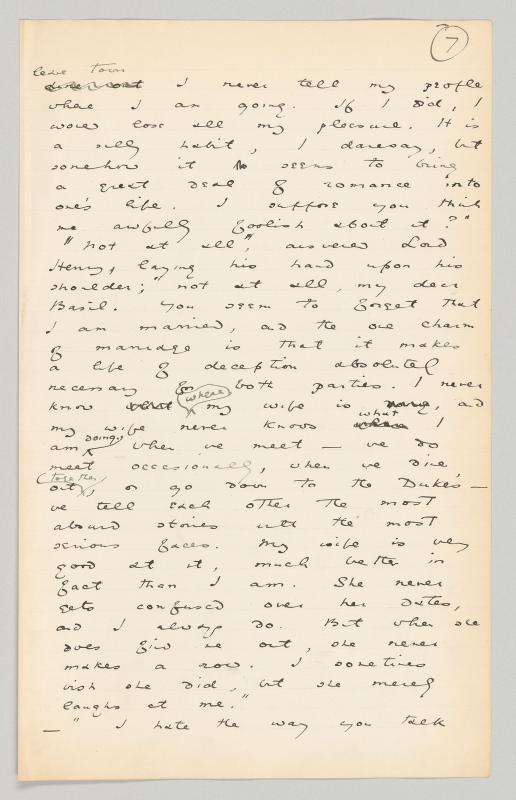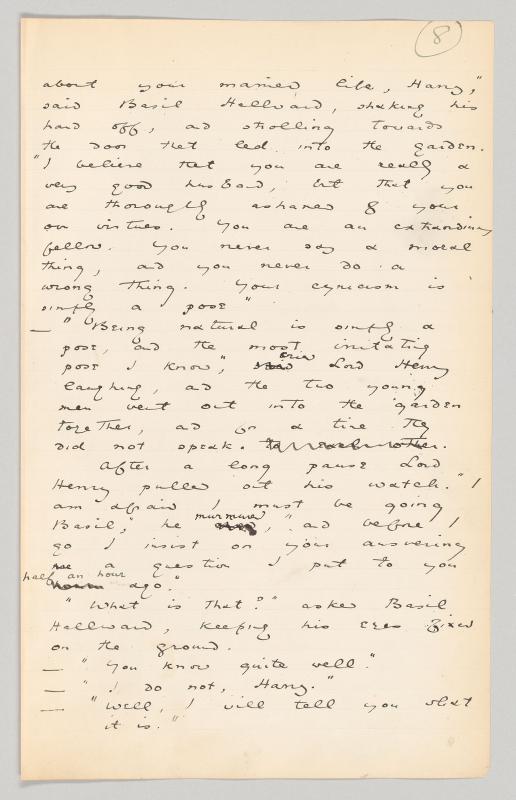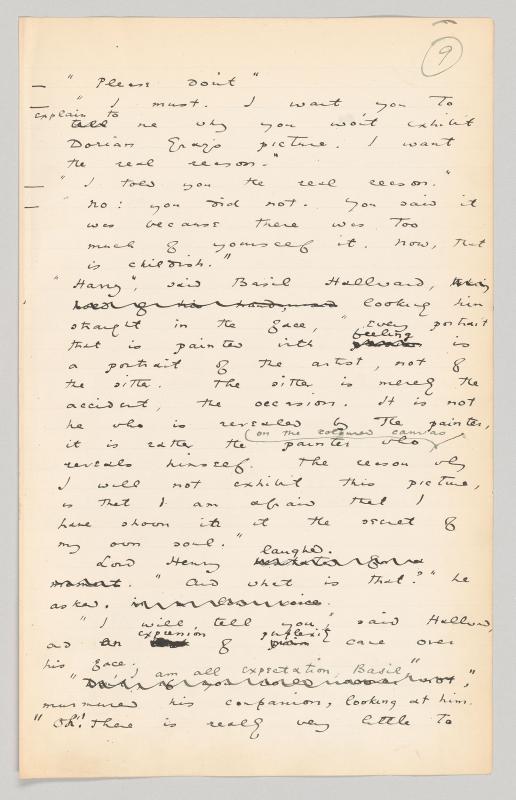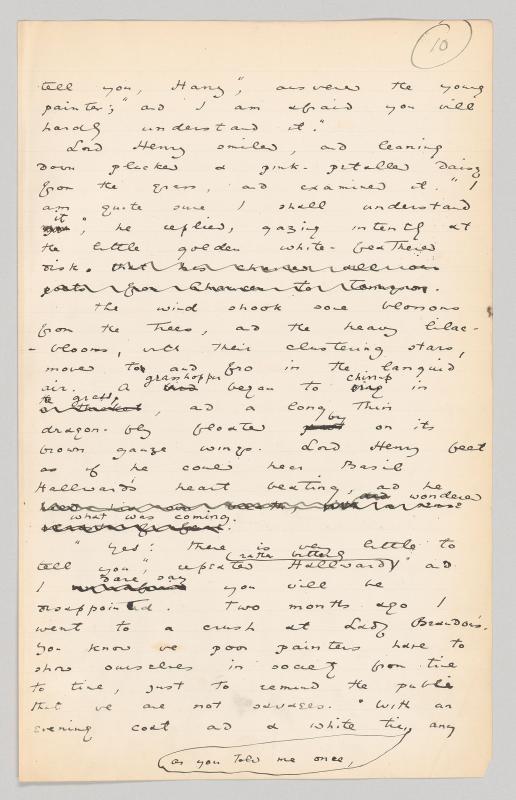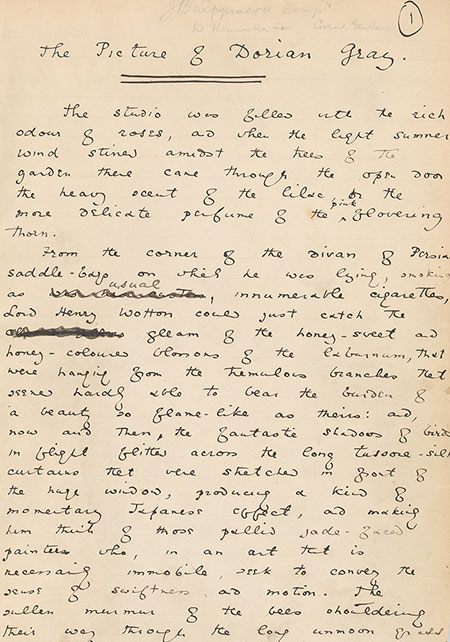
With its memorable tale of ageless beauty and a concealed portrait, The Picture of Dorian Gray stands as one of Oscar Wilde’s most enduring and widely read literary works. Inspired at once by gothic horror fiction, French decadent literature, and contemporary aesthetic theory, the novel incited a storm of controversy in the late nineteenth century for its moral ambivalence and veiled references to queer sexuality. One of the Morgan’s great literary treasures is the earliest surviving manuscript of The Picture of Dorian Gray, the text of which forms the basis for the novel’s first printed edition.
The Picture Dorian Gray debuted as a cheaply printed novella, published in the July 1890 issue of Lippincott’s Monthly Magazine, and sold for twenty-five cents to American readers (simultaneously issued in London by Ward, Lock & Co.). Prior to publication Wilde prepared an annotated typescript of his novella for the Philadelphia editor of Lippincott’s, J. M. Stoddart, who in turn made numerous corrections and changes to the text. But before producing the typescript (preserved at UCLA’s William Andrews Clark Memorial Library), Wilde worked with a manuscript draft that is now held at the Morgan and digitized here. Written in pencil on the manuscript’s first page is the address “J. B. Lippincott Comp., 10 Henrietta St., Covent Garden”; the inscription points to the manuscript’s role in establishing the text published in Lippincott’s Monthly Magazine.
Paleographical and textual evidence establishes that the Morgan manuscript of The Picture of Dorian Gray is not the earliest draft of the novel, but the earliest surviving draft. It is largely a fair copy of the earlier (now lost) draft, yet nonetheless bears significant additions and deletions by Wilde demonstrating how the author labored to hone his only long piece of fiction over several distinct textual versions. Much of the evidence suggesting the Morgan manuscript is a copy rather than an original rough draft centers on places where Wilde has committed “eye-skip,” a common mistake in the manual copying of texts. For instance, on pg. 205 of the manuscript Wilde writes, “‘Nothing is serious now-a-days, at Hallward least, nothing should be.’ Hallward shook his head as he entered.” If Wilde was composing as he penned these lines, it is unlikely he would commit such an egregious error of sense as writing “at Hallward least.” If instead he copied from an earlier manuscript, it is quite possible his eye skipped a line, resulting in the erroneous “Hallward” instead of the correct “least.” (In this scenario it is possible that “least” began the line directly following “Nothing is serious now-a-days, at” and preceded “Hallward shook his head as he entered.”) Donald L. Lawler has compiled numerous instances of such copying mistakes in the Morgan manuscript; through ink analysis, he also demonstrates that when Wilde crossed out erroneous words (such as “Hallward” above), his strikethrough lines have the same color tone as the preceding and following words in the draft: in other words, Wilde recognized and corrected these mistakes immediately and continued copying the text.
But Wilde’s alterations in the Morgan manuscript do not merely relate to mistakes made in copying. A great number of them alter our sense of Wilde’s characters or make significant changes to the book’s narration. On pg. 22 of the manuscript, for example, Wilde has deleted a bit of dialogue attributed to the artist who paints Dorian’s portrait, Basil Hallward. Hallward’s deleted lines, expostulating on the “genius” of Dorian’s beauty, can later be found on pg. 38 of the manuscript, where they are instead given to the aesthete Lord Henry Wotton. This change is one of many introduced by Wilde to diminish the importance of Hallward in the story and amplify the role of Wotton. In other cases Wilde revises the manuscript to deemphasize the narrator’s didactic tone. The version of Chapter Nine published in 1890 closes, for instance, with the striking line, “Dorian Gray had been poisoned by a book.” The Morgan manuscript reveals the original, much overwritten version of the passage: “Dorian Gray had been poisoned by a book and by a picture. Lord Henry had given him the one, and Basil Hallward had painted the other.”
It is well known that Wilde made several revisions to the 1891 edition of Dorian Gray that downplay the homoerotic exchanges of Basil Hallward, Lord Henry Wotton, and Dorian Gray. In some cases Wilde introduced such changes in the manuscript itself, as on pg. 9, where he removes a reference to Hallward clasping Wotton’s hand: “‘Harry,’ said Basil Hallward, taking hold of his hand, and looking him straight in the face.” Likewise on pg. 20, Wilde cut an additional two sentences that expanded Hallward’s description of Dorian Gray sitting for his portrait: “ … while I was painting it, Dorian Gray sat beside me.’ And, as he leaned across to look at it, his [illegible] hairjust brushed my cheek touched my hand.’ The world becomes young to me when I hold his hand, as when I see him, the centuries yield all up their secrets!’”
At other points in the manuscript Wilde adds material. In Chapter Four (pg. 82), within a larger discussion between Hallward and Wotton about Dorian Gray’s unexpected love affair with the actress Sibyl Vane, Wilde inserts a bit of dialogue accentuating the class differences between the young lovers: “But think of Dorian’s birth, and position, and wealth. It would be absurd for him to marry what you call a little actress.” Near the end of the novella in Chapter Twelve (pg. 228), Wilde embellishes a description of Dorian Gray’s cherished copy of Gautier’s Émaux et Camées by adding a detailed account of its decorated covers: “The binding was of citron-green leather with a design of gilt trellis-work and dotted pomegranates.” The Morgan’s manuscript of Dorian Gray also features the original closing lines of the book, revised in the typescript Wilde prepared for publication in Lippincott’s Monthly Magazine; most notably, these lines refer to a “dead body” instead of a “dead man,” lying on the floor “with a knife in his its heart.”
The manuscript of The Picture of Dorian Gray entered the Morgan’s collection in 1913, when it was acquired from the collector and fellow financier Eugene Meyer Jr. (1875–1959) for $2,500. The manuscript had previously been held in Louis I. Haber’s book collection, which sold at auction in 1909.
Introduction written by Philip S. Palmer, the Robert. H. Taylor Curator and Head of the Department of Literary and Historical Manuscripts at the Morgan Library & Museum. The author acknowledges assistance in preparing this introduction from the work of Joseph Bristow, Nicholas Frankel, and Donald L. Lawler.

